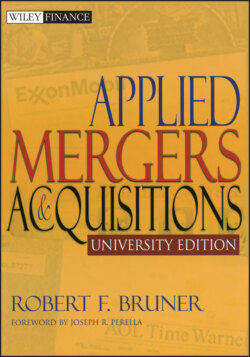Читать книгу Applied Mergers and Acquisitions - Robert F. Bruner - Страница 57
Returns to Buyer and Target Firms Combined
ОглавлениеFindings of positive abnormal returns to the seller and breakeven returns to the buyer raise the question of net economic gain from this event. The challenge here stems from the size difference between buyer and target: typically, the buyer is substantially larger. Hence, a large percentage gain to the target shareholders could be more than offset by a small percentage loss to the buyer shareholders. A number of studies have examined this by forming a portfolio of the buyer and target firms and examining either their weighted average returns (weighted by the relative sizes of the two firms) or by examining the absolute dollar value of returns. Exhibit 3.7 reports the findings of 24 studies. Almost all of the studies report positive combined returns, with 14 of the 24 being significantly positive. The findings suggest that M&A does pay the investors in the combined buyer and target firms.
EXHIBIT 3.6 Studies Reporting Long-Term Returns to Acquirers
| Study | Cumulative Abnormal Returns | Sample Size | Sample Period | Event Window (Days) | % Positive Returns | Notes |
|---|---|---|---|---|---|---|
| Mandelker (1974) | –1.32% successful bids only | 241 | 1941–1963 | (0,365) | N/A | Mergers only. Event date is date of consummation of the deal. |
| Dodd, Ruback (1977) | –1.32% successful –1.60% unsuccessful | 124 48 | 1958–1978 | (0,365) | N/A | Tender offers only. Event date is date of offer. |
| Langetieg (1978) | –6.59%* successful bids only | 149 | 1929–1969 | (0,365) | N/A | Mergers only. |
| Asquith (1983) | –7.20%* successful | 196 | 1962–1976 | (0,240) | N/A | Mergers only. |
| –9.60%* unsuccessful | 89 | |||||
| Bradley, Desai, Kim (1983) | –7.85%* unsuccessful bids only | 94 | 1962–1980 | (0,365) | N/A | Tender offers only. |
| Malatesta (1983) | –2.90% whole sample –13.70% *after l970 | 121 75 | 1969–1974 | (0,365) | N/A | Mergers only. Event date is date of approval. |
| –7.70% smaller bidders | 59 | |||||
| Agrawal, Jaffe, Mandelker (1992) | –10.26%* | 765 | 1955–1987 | (0,1,250) | 43.97% | Mergers only; five-year postmerger performance; tender offer postacquisition performance is not significantly different from zero. |
| Loderer, Martin (1992) | +1.5% | 1,298 | 1966–1986 | (0,1,250) | N/A | Mergers and tender offers; five-year postacquisition performance. |
| Gregory (1997) | –12% to –18%* | 452 | 1984–1992 | (0,500) | 31% to 37% | Uses six variations of the event study methodology; U.K. mergers and tender offers; two-year postacquisition performance. |
| Loughran, Vijh (1997) | –14.2% merger +61.3%* tender | 434 100 | 1970–1989 | (1,1,250) | N/A | Five-year postacquisition returns; segment data also available on form of payment. |
| –0.1% combined | ||||||
| Rau, Vermaelen (1998) | –4%* mergers +9%* tender offers | 3,968 348 | 1980–1991 | (0,36 months) | N/A | Three-year postacquisition returns, with insights into value and glamour investing strategies. |
| Louis (undated) | –7.3%* successful –18.4%* unsuccessful | 1,297 308 | 1981–1998 | (0,3 years) | N/A | Comparison of successful and unsuccessful acquirers. |
| Pettit (2000) | –25.41%* | 216 | 1977–1993 | (0,3 years) | N/A | Tender offers, French sample. |
| Ferris and Park (2001) | –19.80%* | 56 | 1990–1993 | (l,+60 months) | N/A | Sample of mergers in the telecommunications industry. |
| Kohers, Kohers (2001) | –37.39% | 304 | 1984–1995 | (1,1,250) | N/A | Sample of technology mergers. |
| Moeller, Schlingemann, Stulz (2003) | –4.1% | 12,023 | 1980–2001 | (0,36 months) | N/A |
Unless otherwise noted, event date is announcement date of merger/bid.
*Significant at the 0.95 confidence level or better.
